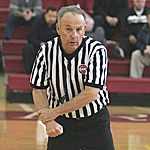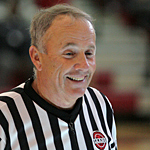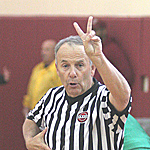Do you have a question? Have you seen a play you didn't understand? Was there a controversy you'd like clarified? Send your questions in and I'll do my best to get you an answer!
Skip Yutzler
IAABO Board 127
44 Years High School and Junior College Official
Selected 5 times to officiate at the
New York State High School Championships
2015 TRAVEL TEAM SEASON
With Veteran Long Island Official Skip Yutzler
June, 2015
Well, the dust has settled, the champions have been crowned, and the summer is upon us. Summer leagues and camps will set the tone for the season ahead for players, coaches and.....yes....referees! But it doesn't mean we can't get into some more questions from our readers. So, let's dig in with eight recent questions.
QUESTION - Offensive player, A-1, with ball in back court throws to teammate, A-2, who is completely in the FRONT court. A-2 jumps and, while in the air, catches the ball and lands completely in the FRONT court. Whistle blows....violation! I wouldn't think this to be the case because the player caught the ball in mid air and came down with both feet in front court. Am I missing something here?
ANSWER - YOU are not missing anything! If the play occurred exactly as you described it, the referee who made that call is the one who missed it.
A-2 already had front court status and when he caught the ball from the back court, the ball then had front court status. Even if A-2 jumped from the back court and caught the ball in mid-air and then landed in the front court, it would not be a back court violation. I can't imagine what that referee was thinking!
QUESTION - If a player leaves the ground for a shot and the defender blocks the shot but does not have his hand on the ball when the shooter comes back down with the ball, is it traveling or jump ball?
ANSWER - By rule, that's a HELD BALL (jump ball.....). It is not a traveling violation. The simple fact that the shooter was prevented from shooting by virtue of the defender's hand on the ball is enough to warrant the held ball call even if the defender was unable to keep his hand in contact with the ball all the way back down.
QUESTION - Can an offensive player with both hands on the ball push a defender away using the ball or is that a foul on the offense?
ANSWER - It would be a "player control foul." Think of it this way......We already know it is okay for the defender to slap the hand of an offensive player while that hand is in contact with the ball. We say that "the hand is part of the ball....." by way of explaining this in the simplest terms.
Now, reverse this. IF the hand is part of the ball, then it also makes sense that the ball in contact with the hands is nothing more than an extension of the offensive player's hand(s). If he pushes off (gains an advantage.....) with just his hands, we would call a player control foul. So, in this case, it would still be a player control foul because that ball now becomes an extension of his hands. It's not called often, but it doesn't mean it isn't a foul.
QUESTION - Can a player rebound his own missed free throw? Does it matter if it hits the backboard or goal? I say a player can and my husband says no. We are currently glaring at each other. Any assistance would be appreciated.
ANSWER - If the ball doesn't hit the goal, it's a violation by the shooter. It's not enough to simply hit the backboard. Immediately upon it becoming obvious that the ball will not hit the goal, the play is whistled dead and either goes over to the defense or the shooter might get the 2nd shot of a 2 shot foul (or the 3rd of a 3 shot foul).
But if the ball hits the goal, all bets are off. The shooter can get the rebound of the missed free throw and play on just like any other rebounder. Looks like you won that bet!
QUESTION - We play pick up games at a gym near my house. Usually I have a defender on me that's feisty. When going up for a lay up he doesn't use his hands but mainly pushes off with his stomach/chest. Is that a foul?
ANSWER - The key to this play is the word "DISLODGE." If the defender "dislodges" the shooter and gains an advantage in so doing, it is a foul on the defender. This does NOT mean "brush contact" where there is slight contact that has no discernible effect on the shooter. That would be considered "incidental contact" and should be ignored. But, if the contact has a noticeable effect on the shooter......that is, the shooter is "dislodged" from his intended path to the goal, it's a foul.
QUESTION - (similar to above)
How far is it legal for an offensive player to "back down" a defender before it is considered charging?
ANSWER - The key word (as above) is "DISLODGE." The defender is allowed to "seal" the offensive player, but he cannot do anything to "dislodge" the offensive player from his intended path. Conversely, the offensive player can "back down" the defender until he meets a little resistance from the defender who is, presumably, "sealing" off the offensive player. But once he hits that resistance, that's it. He is not permitted to "dislodge" the defender who has him legally sealed off. If he does, it is ruled a "player control foul."
QUESTION - Is it legal in basketball to throw the ball into the air to avoid being fouled in the final seconds? Example: Team A is up 1 point with 3 seconds left and they inbound and immediately throw the ball so high it doesn't hit the ground before time expires. Is a technical foul called?
ANSWER - It is legal.....assuming it doesn't hit the ceiling! It's really no different than throwing a length of court pass or even a full court shot. It is not a technical.
QUESTION - During the NCAA playoffs in the Texas vs Butler game with a little over 3 minutes left in the 2nd half, Texas made a basket. Butler inbounded the ball and then called timeout when the shot clock was at 30 seconds. Afterwards, Butler inbounded the ball again and clearly was not over the line when the shot clock read 24 seconds. If the offense calls timeout, do they get a new 10 seconds?
ANSWER - Yes, in NCAA and Federation (high school) play after the time out, there is a new 10 second count. Sometimes the time out is the only thing available to prevent the offensive team from getting hit with a 10 second violation. Perfectly legal.
BUT.......STAY TUNED.......that rule may change in NCAA play going into the 2015-16 season. We will keep you posted!
Ask The Ref !




